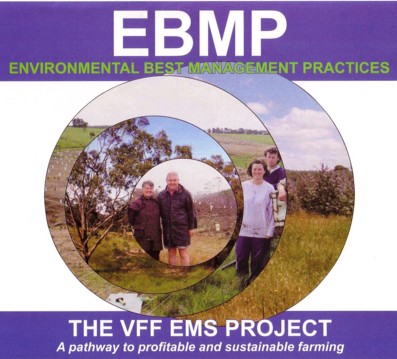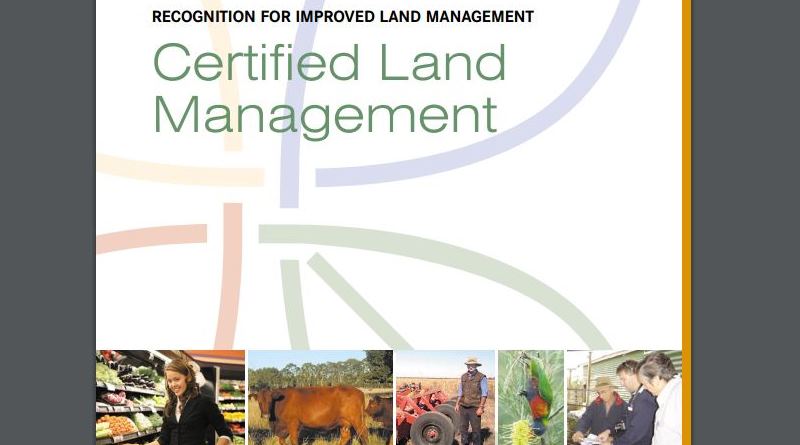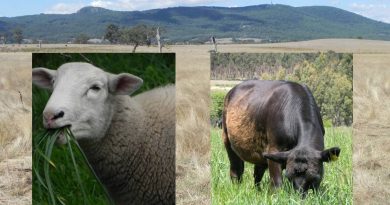Selling food and fibre sustainability – what’s in it for Australian agriculture
By Tony Gleeson
Not a day goes by without hearing or reading about the litter of features characterising Australian agriculture—efficient, not subsidised, innovative, safe, traceable, reliable, clean and green.
In a vague sort of way we already endlessly promote our ‘greenness’-our ecological sustainability – through the ‘clean green’ mantra. Yet of all the features the green feature is the one least verified. It is the one least linked to particular products or producers. It is not traceable. It is the runt of the litter.
The question today is not about selling sustainability. We already do that. It is about whether we should do it better; do it in a way that delivers benefits; do it in a way that protects both landholders and the environment. There are many reasons why we should do so.
The first has to do with improving competitiveness – the ability to compete. There is a renewed focus on competitiveness. We have the Government Task Force on Agricultural Competitiveness. The Business Council has reported on competitiveness. The just released Australian Farm Institute spring journal is dedicated to competitiveness.

The analysis of competitiveness is generally focused narrowly on the cost of market access, on production costs and on costs along the supply chain. We are driven by the cost part of the cost price squeeze. We judge ourselves to be price takers unfairly treated by markets, climate, supermarkets and environmental and animal welfare advocates.
So we look only to improving the cost of access, to cutting costs through improving infrastructure, to reducing on-farm costs. Linked with this is a false belief that we have sustained the profitability of the sector through productivity improvement which essentially has been about producing more volume from the same inputs.
All of this is important. But it has not been sufficient and it won’t be in the future.
Commodity price mentality
It is not sufficient because the root of the problem is price. We sell the volumes we produce. Lowering access barriers for low margin products has not been and won’t be the solution. Generic branding that does not reward marketing efforts directed at the wants of higher wealth consumers has not been and won’t be the solution.
The prediction for what is necessary for the next forty or so years is not much different to what has happened over the forty or so years to the turn of the century. We increased volume of production threefold and world trade increased three fold. Yet the real gross value of production and the real aggregate cost did not change much. What changed was profitability – it fell – by a third in the last decades of the last century.
The past Secretary of the Treasury Ken Henry put his foot on it when he proposed we need to not ignore but move beyond a focus on costs to exporters — what he called a mercantile approach to competitiveness. We need also to take account of attributes that are our greatest assets in doing business in Asia – our strong institutions and governance, our concern for environmental sustainability and animal welfare, and our protection of safe and rewarding working conditions.
It is what Laure Latruffe made passing comment about in the Farm Journal —‘While this (her)article, as well as the existing literature, focuses on price or cost competitiveness, the non-price component of firms or farms competitiveness (product differentiation, quality, design, novelty, reputation, reliability etc) is an important aspect in gaining market share and sustaining profits’. Perhaps the solution lies in pricing what Latruffe calls the non-price component?
This vision of competitiveness is what David Crombie and Jason Strong are on about when they say AACo does not want to compete with low cost producers; that the focus needs to be on supplying differentiated products to higher priced markets. Others in this deafening chorus include:
- Brent Finlay—‘A clean green image gives Australia a great advantage in export markets ‘— Rural Press Club Melbourne Showgrounds – September 2014
- Past GrainCorp CEO Alison Watkins at a New South Wales Farm Writers’ Association meeting August 2013—“Our edge in Asia will be as a reliable supplier of high margin, safe, green and high quality food. Australia must strive to be the “developing world’s delicatessen”, deliberately avoiding competing in a “low-margin supermarket role”.
- Lion Chief Executive Stuart Irvine –The Australian Sept 11th 2014-‘Australia’s hopes of becoming a food bowl for Asia will rest on providing value-added products—where price counters high local costs’
- Gary Dawson-Australian Food and Grocery Council-www.the australian.com.au/midmarket (August 2014)-in relation to food products —“—what looks like quite a small niche is actually a huge opportunity for Australian producers when they get their pitch right in terms of provenance and quality and taste”
- Just about every keynote speaker and panellist at the recent Landcare Conference in Melbourne.
- And more broadly the International Bar Association Task Force has recommended creating a new human right to a safe clean healthy and sustainable environment.
‘Green’ is the feature most distinguishing, the feature most difficult to replicate. And together with animal welfare it is growing in importance. Technology, in particular the internet and higher incomes are disrupting influences – moving us from being production driven very quickly through or around being market driven to being consumer driven.
These trends present Australia with exciting opportunities.
Environment and animal welfare QA
Australia has the natural resources and skills to enable it to provide the necessary environmental and animal welfare assurances. Additionally, if done right, it will enable potent market forces to spearhead capture of the growing synergies between improving profitability, improving natural resource and animal welfare management and strengthening workforce dedication and professionalism.
The profit prizes will go to those companies that position themselves to anticipate and respond to consumer aspirations.
Rural producers and their representative organisations tend to reject change stating that there is no market for differentiated products. It is only possible to maintain the view that there is no market for differentiated products if you are not familiar with the evidence – both from Australia and internationally.
Take even a simple illustration. In September I checked three supermarkets for egg categories and prices – IGA in Stanthorpe, Coles in West End and James Street Market in New Farm. These three outlets stock 30 different egg categories. They vary in price from $2.31 to $10.75 per dozen — more than a fourfold variation in price.
Much of our thinking proceeds in the context of opportunities and challenges to do with Asian markets. One could be forgiven for thinking the booming Asian markets have just erupted. But twenty years ago Barney Foran from the CSIRO Futures Program wrote then that it would seem fairly obvious even to the reader of daily newspapers — and that Australians should catch a marketing virus from New Zealand.
And how we might respond did not start with Round Tables (eg the Global Roundtable for Sustainable Beef – see article on www.moffittsfarm.com.au ) or Square Tables or any such recent activities.
It was spearheaded by Genevieve Carruthers in the late 1990s supported by such as the 2000 CSIRO report on the critical design features of a credible EMS for Australian agriculture and the Ministerial agreed EMS Framework in 2002. Our own work was initiated by Jock Douglas and Geoff Penton in the late 1990s. And would not have survived but for the sustained and visionary support from Elders. Cotton was ahead of all this with its Cotton BMP – though I wish they had gone down a different pathway, or that other industries like blind mice had not followed.

We need to stop just talking about responding to this opportunity and actually do something, preferably the right thing.
If we do the right thing – and currently we are not doing so by a very long way – then the related co-benefits will be very substantial.
- First we can better avoid multiple and costly environmental and animal welfare specifications being imposed — not by the ‘green’ enemies identified by Senator Boswell and Rural Press but by powerful and multiple retailers
- Second we can improve soil-plant-animal function — what we in the ALM Group like to call Farm Ecology
- Third we protect and enhance our productive base – surely one of our greatest assets
- Fourth we strengthen social resilience – by working together with shared beliefs and values
- Fifth done right Australian farmers could benefit from the intellectual property and market power embedded in the existing Certified Land Management (CLM) registered certification trade mark.
- Sixth we can dramatically increase the efficiency of delivery of government support – reducing transaction costs, preferentially benefiting landholders doing the right thing, avoiding problems rather than being on a ‘tree-planting’ remediation treadmill
- And very importantly but often forgotten in this commodified world we would actually improve environmental and animal welfare outcomes.
This discussion is not so much about how we might sell sustainability, but why. However the two are interdependent. We should only do it if what we do is right, that is, if the benefits outweigh the costs.
Benefits can outweigh costs
Those who say there should be no cost to farmers are being political. Of course there will be costs. Done right the benefits will outweigh the costs. Done badly it becomes just another cost.
Those who say their focus is on profitability – not environment or animal welfare -are missing the interdependencies. Done right these can help drive profitability.
Proceeding industry-by-industry is not doing it right. For many reasons including that nearly three quarters of agricultural product by value is produced from properties with two or more industries. Only 11 percent of beef by value is produced on beef only properties.
Having verification on the basis of so-called best management practices is not doing it right. Again for many reasons – including because best management practices are largely industry and regionally specific, they are difficult to codify for auditing purposes, they generally don’t have an internationally recognised core element and they tend to constrain innovation.
Take home message
Selling Sustainability – What’s in it for Australian Agriculture? In a nutshell if we do it right it means that innovative farmers and processors and marketers of Australian food and fibre will benefit from what is one of our greatest and most difficult to replicate assets. In doing it right we strengthen our productive natural assets. And in doing it right we provide an excellent basis for payment for ecosystem services much beyond food and fibre products.
Find out more:
Tony Gleeson is CEO, Australian Land Management Group which is responsible for the Certified Land Management program; tony.gleeson@almg.org.au ; www.almg.org.au



